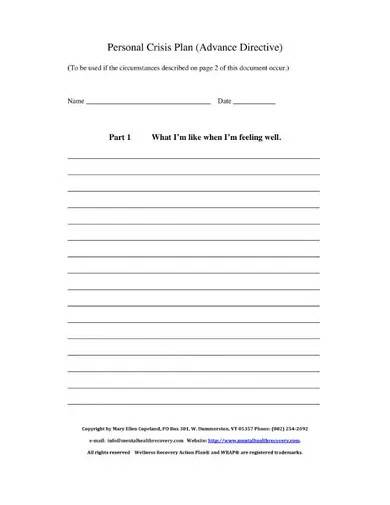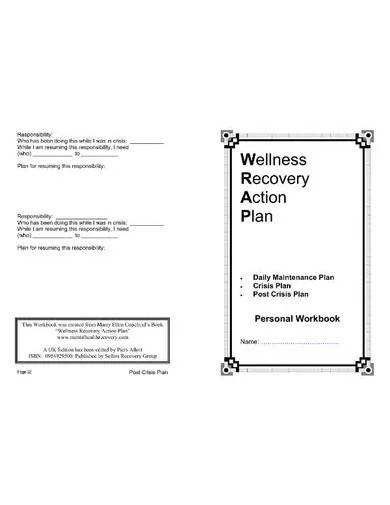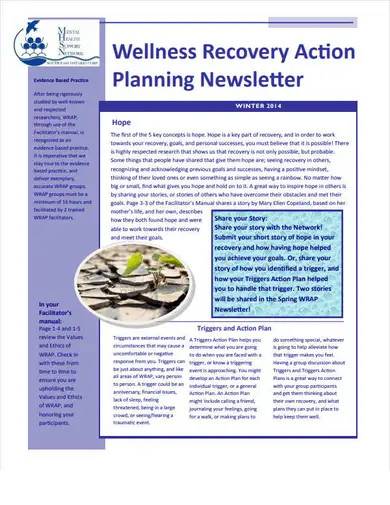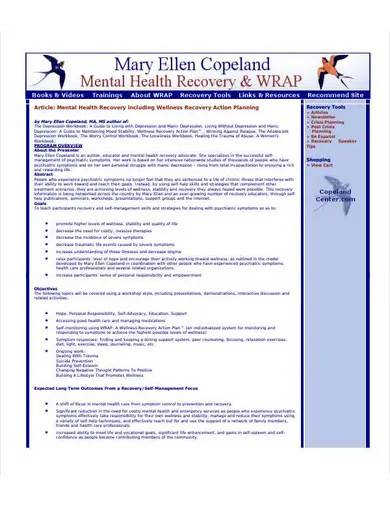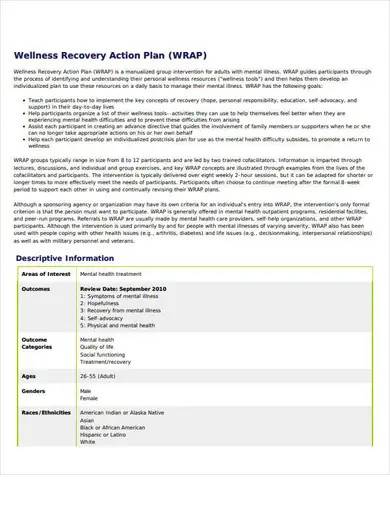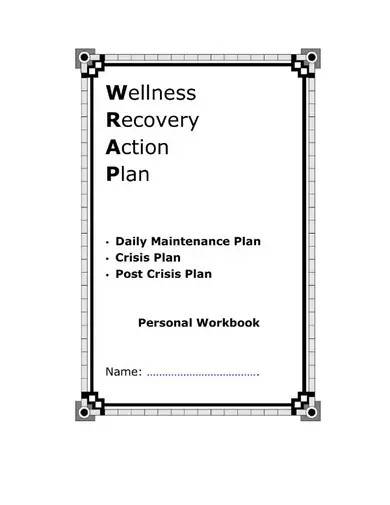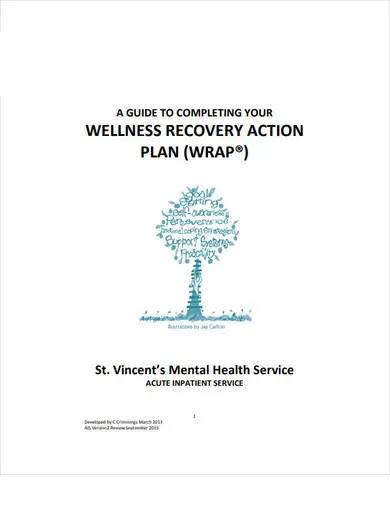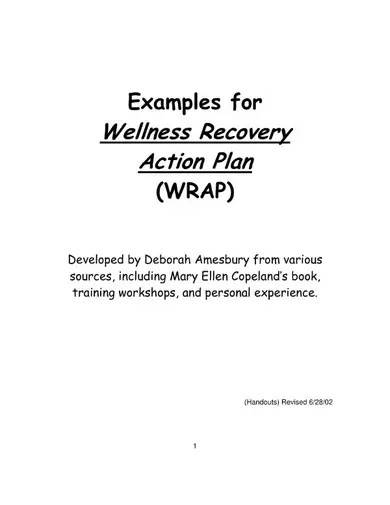Nowadays, we are living in uncertain times filled with difficult problems, challenging circumstances, and distressing feelings such as fear, worry and anxiety. According to several research studies, overwhelming deep emotional traumas and socio-economic stressors brought about by the COVID-19 pandemic and the lockdowns have even caused the more vulnerable people to commit suicide. Also, many findings show an increasing rate in mild to severe depression for many countries such as in the United States, Britain, South Korea, etc. Do you know that the Wellness Recovery Action Plan or WRAP can be used to facilitate mental health recovery? In this article, we have some downloadable plan samples to guide you. Keep on reading!
FREE 10+ Wellness Recovery Action Plan Samples
1. Wellness Recovery Action Plan Template
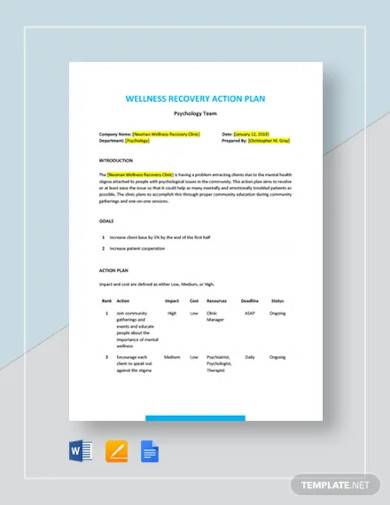
2. Personal Criss Plan Template
3. Wellness Recovery Action Plan
4. Wellness Recovery Action Planning
5. Mental Health Wellness Recovery Action Plan
6. Professional Wellness Recovery Action Plan
7. Wellness Recovery Action Plan Workbook
8. Personal Wellness Recovery Action Plan
9. Sample Wellness Recovery Action Plan
10. Example for Wellness Recovery Action Plan
11. WRAP Plan Template
What is a Wellness Recovery Action Plan?
The book “Community Psychology and Community Mental Health: Towards Transformative Change” defines Wellness Recovery Plan or WRAP as a wellness personal management program that promotes mental health recovery and has the tools to assist participants in maintaining their wellness, organizing their lives, inhibiting recurrence of troubling feelings and behaviors, and assuring them the best possible care in most unbearable situations.
How to Create a Wellness Recovery Action Plan?
Based on a conducted study, WRAP participation has a positive effect on psychiatric symptoms and feelings of hopefulness. Actually, the person is the one who develops his own WRAP. But he or she may select supporters, including health care professionals, to help him or her create his or her WRAP while the individual remains in control of the process.
If you want to develop your own recovery plan, this article will help you with that. Below are some useful tips and ways that you can do:
1. Make your wellness toolbox
Prepare a list of easy and safe strategies that can be used to support wellness. Think of the things that you need or can do to improve your wellness or feel better when you are struggling emotionally or physically. First, consider what you are already doing to maintain wellness, along with what you feel you should do to foster your recovery. Some common examples of personal strategies are taking a daily shower, brushing teeth and hair, drinking eight glasses of water daily, taking vitamin supplements, exercising, eating three meals per day, etc. The toolbox may also include creative activities such as writing or journaling, drawing or painting, playing a musical instrument, etc. Take note to write down a short list of your strategies and avoid doing too much in your capacity.
2. Establish a daily maintenance plan
This section of WRAP has three parts:
- Your feelings and behaviors when you’re okay – Consider what you feel or behave when you are well. Write down the things in a list or in a paragraph form. You may also include a picture of yourself at a time when you specifically feel happy and satisfied. If you can’t remember the time you feel well, describe what you think you might feel when you are well.
- Things you must do daily to stay well as possible – Review your wellness toolbox and select the tools you will use daily to prevent mental health struggles and promote good health. For example, doing 30-minute exercise, taking medications, eating balanced meals, chatting with a close family member or best friend, etc.
- Things you need to do on any particular day to stay well – Search for particular activities that you can plan and do regularly but not daily. These things include reading a book, vacuuming, grocery shopping, paying a bill, having a special night time skincare routine, etc.
3. Know your triggers and early warning signs
To improve your understanding and experience of mental health, an article recommended to increase your awareness with your emotions by identifying your triggers and early warning signs or troublesome feelings.
You can do these activities to prevent a possible relapse like taking a “mental health day” away from work and other responsibilities, working on an art project, going for a walk or run, spending some time with your family members or a group of friends, etc.
4. Set a crisis and post crisis plan
Based on an article, setting a crisis plan allows you to maintain some degree of control over your life even when it feels like everything is out of control. Work on it with your family members or friends, your counselor, or whoever feels comfortable to you. After the crisis, you will work on your post crisis plan. Do things like making amends, reconnecting with your family members or friends, etc.
FAQs
A wellness recovery action plan can help you think about and share what supports your mental health at work, contemplate about and inform others what makes you unwell at work, know and let others become familiar about the things that can help keep you well.What is the importance of a wellness recovery action plan?
Based on this article, the basic elements in making a recovery plan are the following:What are the key elements in making a wellness recovery plan ?
According to this reference, the 10 fundamental components of mental health recovery include the following principles:What are the 10 core dimensions of recovery?
WRAP is a wellness and recovery approach that helps people to minimize and avoid intrusive or troubling feelings and behaviors, boost personal empowerment, enhance quality of life, and fulfill their own aspirations and dreams.What is the wrap model?
Undergoing the methods and procedures of Wellness Recovery Action Plan or WRAP is like immersing oneself in a peaceful sanctuary like being in a tranquil garden as one will feel the true essence of his or her own life and realize wonderful things around him or her. Thus, WRAP consciously reflects the principles of a new paradigm of mental health that facilitates metamorphic change of individuals and routines. If you want to become a mental health facilitator or someone who wants to improve his or her overall health, you can learn and apply these simple methods of WRAP. Plus, here are some of our downloadable and printable action plan samples. Start downloading them now!
Related Posts
Food Menu List Samples & Templates
Argumentative Writing Samples & Templates
Contract Cancellation Letter Samples & Templates
Sample Material Lists
Sample Excuse Letter for School
Feature Writing Samples
FREE 14+ Sample Music Concert Proposal Templates in MS Word | Google Docs | Pages | PDF
FREE 10+ Security Guard Contract Samples in PDF | MS Word
FREE 10+ Assurance Agreement Samples In MS Word | Google Docs | Apple Pages | PDF
FREE 10+ Option to Purchase Agreement Samples in MS Word | Apple Pages | PDF
FREE 26+ Curriculum Form Samples in MS Word | PDF
FREE 20+ Cleaning Service Proposal Samples in PDF | MS Word
FREE 29+ Sample Loan Application Form Templates in MS Word | PDF
FREE 10+ Event Venue Contract Samples in PDF | MS Word | Pages | Google Docs
FREE 10+ SBAR Samples in PDF | DOC

